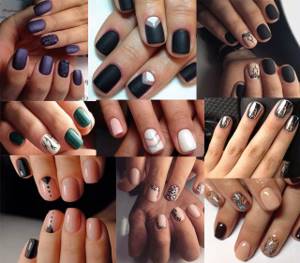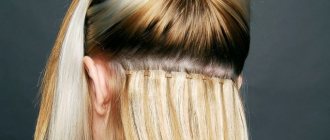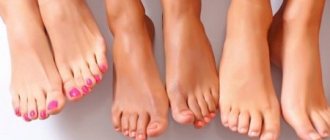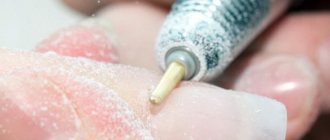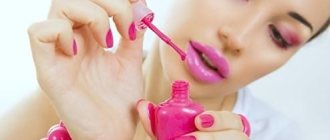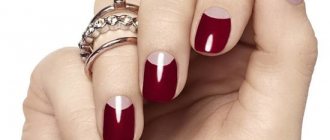Often girls want to have a well-groomed, feminine manicure with long nails, but the length of the natural plate may not be enough for this. Then they have to resort to extension of the nail bed, which can be difficult.
Before performing the procedure, you should always pay attention to the condition of the nail bed, its length, then questions arise whether it is possible to extend nails on very short nails, although specialists usually do not prescribe any special restrictions in this area.
Proper care of extended nails
- The first day after the extension procedure
is special for you. Firstly, you need to get used to and adapt to artificial nails. It is necessary to treat extended manicure as carefully as possible. Try not to bang your nails on the table or do work that requires a lot of effort. Better put off cleaning until tomorrow. Also, “new” marigolds do not like sudden temperature changes. Therefore, avoid visiting a bathhouse or sauna. Minimize water treatments. - In the future, carry out all work around the house or in the garden wearing thick rubber gloves
. Buy quality gloves, ones that won’t tear after half an hour. - To remove polish from artificial nails, use a liquid without acetone.
- If you are reapplying varnish to artificial nails, first of all, paint over them with a base coat. Gel nails without a base can become stained. And the varnish applied to the base will last much longer.
- If you need to file an extended nail, you should use a file with an abrasive coating - more than for natural nails. Do not attempt to trim your extended nails yourself
. Doing this will ruin your manicure. - If the nail plates have grown a little, and the border between natural and artificial nails has become visible, then it can be corrected using a grinder file.
- Don't forget to pay attention to the cuticle
. Use a special cuticle oil, and then use a wooden spatula to gently push it towards the base of the nail. Do not steam your hands before caring for your nails. - Extended nails need correction. You won't be able to do this on your own. The frequency of visiting a specialist depends on the characteristics of your body, that is, on the rate of nail growth. For some, it is enough to make a correction once a month, and for others once every two weeks. The correction does not take much time. But it is necessary to do it, otherwise your nails will look untidy.
- Remember that your natural nails need rest and time to recover. Therefore, it is not recommended to constantly wear artificial nails
. You are risking the health of your own nails. They can change beyond recognition, and getting them back to their original appearance can be challenging. Remove extended nails for 3 weeks once every six months. During this time, take extra care of your native nails. - Clean the inside of your nails regularly with a soft brush. A lot of dirt and dust accumulates under them.
Enjoy the sight of your beautiful and delicate hands. To care for them, use only high-quality products that do not contain substances that can damage the extended nails.
Beautiful, well-groomed nails are an integral part of every woman’s image, just like a well-styled hairstyle, a stylish handbag, and impeccable makeup. And being the owner of such an attribute today is not at all as tiring as it once was. With the help of nail extensions, many have long forgotten that the original plates were brittle and unattractive in color, and were difficult to shape or paint neatly. But to maintain a beautiful manicure, caring for extended nails must be thoughtful and attentive.
Extended nails do not last: main reasons
Extended nails are no longer a novelty on the nail industry market, and almost every woman has treated herself to such a beautiful manicure. But at the same time, every third lady was faced with such a problem as the falling off of extended nails after a week, which can manifest itself in the form of small air bubbles under the gel and cracks. A logical question arises: “Why does this happen if the master promised a beautiful manicure for 4-5 weeks?”
There can be many reasons, but the most common among them are:
1. Violations in extension technology. Due to his inexperience or negligence, a manicurist may make mistakes such as:
- poorly polished nail plate;
- areas near the cuticle are poorly cleaned;
- dust has not been removed from the nail plate;
- contact of gel or acrylic with skin;
- The nail drying mode in the UV lamp is incorrectly selected;
- when filing your own nail, using a file with rough abrasiveness, low-quality materials, saving on acrylic, gel. After all, one master uses KODI extension gel, another uses a Chinese analogue, and accordingly this is the result.
How to solve the problem: change the master.
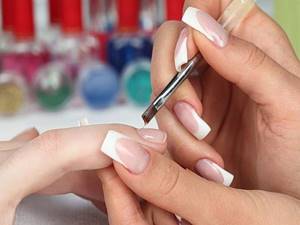
2. Untimely correction.
The first correction after extension is done after 3 weeks, and the subsequent one after 4-5 weeks. If you save on corrections, then be prepared for the fact that you will come to the master without 2-3 nails, which will simply fall off after the allotted time.
Exit: follow the correction mode.
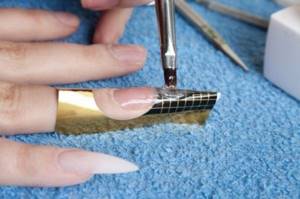
3. Physiological state of the body.
How long the extended nails will last also depends on the physiological state of the body.
Before starting the extension process, an experienced master must warn the client that artificial nails cannot be created if:
- infectious or inflammatory processes occur;
- nail plate fungus;
- taking hormonal drugs, antibiotics;
- critical days;
- pregnancy, breastfeeding;
- severe sweating of hands;
- thin own nail plate;
- thyroid diseases.
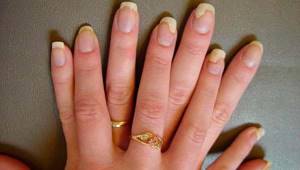
Having health problems and agreeing to this procedure, you must clearly understand that you will not be admiring your extended nails for long: a maximum of 1-2 weeks. Therefore, you should weigh the pros and cons, since such a procedure from a good master is not cheap.
What to do: first you need to strengthen your physiological state and only then go to a beauty salon to see a manicurist.

If you are confident in the condition of your body, in the experience of the master, but your nails do not hold up well, then the reason should be looked in a different direction: perhaps you are not following the rules of nail care correctly:
• keep your hands in the water for a long time; • do housework without gloves; • mechanical damage to the plate. • self-filing of the nail with a nail file for the wrong purpose.

Thus, beautiful and durable nail extensions depend on:
• skills and experience of the master; • quality of materials used; • physiological state of the body; • rules of care.
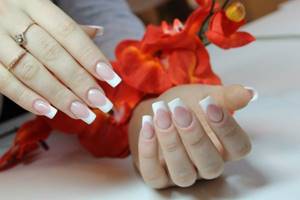
Previous article: Modern eye diseases Next article: How to protect yourself from street noise
Where to begin
After completing the extension procedure, remember that you cannot:
- wet your hands for the first couple of hours. Although this rule is disputed by many, some experts generally recommend not moisturizing your hands with anything during the day. Of course, this requirement is contrary to common sense and hygiene rules, so it is enough to wait 2 hours.
- in the next 24 hours, take a hot bath or steam in a sauna. Before they completely harden, nails are still sensitive to sudden changes in temperature, and even more so to excessive heat.
- banging your nails on the table or making sudden movements. Now your nails are quite fragile, despite the fact that they are stronger than natural ones, but they are easy to break, which can simultaneously lead to painful injury to the native horny plate.
At first, many find it difficult to carry out their usual procedures, especially if the new nails are too long. But after a few days, they are perceived in the same way as their relatives, and do not interfere at all with doing any work. However, care should not be canceled.
Types of nail extensions
Gel and acrylic coatings are very durable, but they are different materials in structure. When choosing between them, evaluate your type of activity and area of occupation. For those whose work involves daily contact with water, gel nails are better suited. Water, sweat, and various oils can get under the acrylic nail and cause fungus. Therefore, athletes, hairdressers, cosmetologists and massage therapists are better off choosing gel polish.
The cost of a manicure will also vary. Acrylic is cheaper than gel. An acrylic extension session will take an hour, the result will last about three weeks. When the nail grows noticeably, the material will need to be replenished. Repairing and adding material takes half an hour.
Gel manicure is more expensive. It will last on average ten days, but there are also women who wear their nails for three weeks, but this is most likely the exception. The time required for the procedure is 50 minutes. Repairing a gel nail is difficult; it is easier to remove the damaged material and apply a new one.
Acrylic nail extensions
Acrylic nails are a two part system made of liquid and powder. When the monomer and polymer are mixed, a thick consistency is formed in the form of a hard layer covering the natural nail. The material hardens in air. When the acrylic hardens, varnish and all sorts of creative designs are applied to it.
The disadvantage of acrylic is that if the nail bed is damaged, a breeding ground for fungus and bacteria can be created between the material and the nail plate.
Acrylic manufacturers note that the material contains strong chemicals and gases - so if you are pregnant, do not do acrylic manicure during the entire period.
A broken nail can be easily repaired by applying material and polishing the edge. Nails are removed with a regular acrylic solvent, without damaging filing.
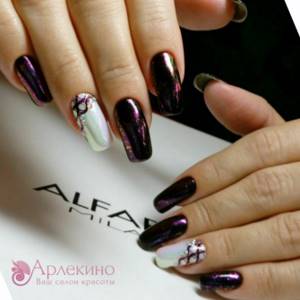
Gel nail extensions
Gel nails look more natural than acrylic nails. The material hardens in a lamp under the influence of UV light. Extensions are similar to a classic manicure - a base layer is applied, then colored varnish, and finally a finishing coat. The material does not contain harmful fumes, does not smell and is considered a safe, environmentally friendly manicure option. Gel is a thick varnish, so in the end the nails look very natural, flexible, strong, but not thick. Fungus does not form under them. Gels are single-phase, two-phase, three-phase. Colored, transparent and matte.
Among the disadvantages of the technology, it can be noted that the material is removed using a solvent and cutting, which can overdry and damage the natural plates. Therefore, between extensions, use nourishing caring oils for your nails.
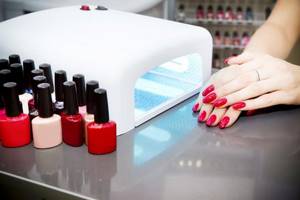
Nail extension with biogel
Biogel is a type of gel extension. Lasts like regular polish for 5 to 10 days. Due to the natural components included in the composition, this type of extension is suitable even for pregnant women. The procedure is odorless and comfortable. The basis of the biogel is mulberry resin. Therefore, extensions belong to the class of therapeutic manicures. The procedure takes care of thin nails, strengthens them, and helps to grow healthy nail plates. Adhering well to the surface of the nail, the biogel does not allow moisture to pass through, so the formation of fungal infections is excluded.
Rules for caring for extended nails
Women who do all the housework themselves should pay close attention to the listed rules, since artificial nails suffer the most during cleaning and washing dishes. But those who share these responsibilities with assistants need to remember that to care for extended nails
special procedures are required.
- The very first and most important rule: use rubber gloves for any housework! This is necessary not only to maintain the integrity of the artificial plates, but also for the health of the skin.
- Polish on extended nails should absolutely not be removed with products containing acetone.
- It is forbidden to use ordinary manicure devices - nippers, scissors, iron files.
- Remember to be careful and do not test your nails for strength.
- When removing cuticles, do not soak your hands. Use emollient oils and products to slow down cuticle growth.
- Extended nails can only be coated with special varnishes for this purpose.
- It is necessary to carry out the correction in a timely manner. Typically this happens every three weeks.
- You cannot do a hardware manicure, which will thin the artificial plate and make it brittle.
- It is strictly forbidden to remove the extended nail yourself!
- You should not change the varnish every day, this harms the condition of both the acrylic and gel layers.
- To paint the gel plate, be sure to use a base coat, otherwise the nail itself will be stained.
- Once every two years or even more often it is necessary to take a break and remove the extended nails for 2-3 months.
- You cannot take baths with salt or herbal infusions; this will not benefit artificial plates, despite the fact that the skin of your hands “loves” such procedures.
A specialist will help you select the necessary accessories.
Perfectly extended nails
In order to perform perfect nail extensions, you need to get good at every stage of their modeling. Here we will look at what criteria ideal artificial nails, both acrylic and gel, must satisfy, so that the work can be presented at competitions and championships for nail technicians.
- General appearance of nails. Artificial nails must have clear, even contours, the same length and shape, as well as shine.
- The very shape of the nails. It is selected not randomly or on demand, but according to the shape of natural nails and the shape of the fingers.
- Length of artificial nails. Her choice should also be justified by the length of the client’s nail bed.
- Cuticle area. This area is always given a lot of attention when working, since this is where a new nail is born. The main requirements are a smooth, almost imperceptible transition from a natural nail to an artificial one.
- The shape of the transverse bend (C-bend). The inner surface must correspond in shape to the outer one, the arch must be the same in shape on all nails, and in terms of bending, an arch of 50% of the circle is considered ideal.
- Longitudinal bend of the nail. Here they look at the same shape of the nails when viewed from the side.
- The thickness of the free edge of the nail. Ideally, it should not exceed three quarters of a millimeter in height (approximately the size of a plastic card). Naturally, its uniform shape and absence of irregularities are checked.
- No air bubbles. When modeling nails, they often appear, which gives the nails a not entirely aesthetic appearance. In the French area, it is checked to see if there is a “marble effect”.
- The shape and clarity of the smile line. The shape of the smile should be the same on all extended nails, high and even, without detachments.
- Side lines. The material at the side lines should also smoothly transition from the natural nail, receding to a thin hair, almost invisible to the eye. The lines themselves on the sides should be smooth and parallel to the finger on all nails.
- Cleanliness and tidiness. Modeled nails should not show any traces of acrylic or gel, dust or any other foreign materials.
- Glitter top coat for nails. Nails, both acrylic and gel, should have a perfect shine, without areas of dullness, marks from a file or sander.
During competition entries, a French manicure is made on one hand using the technology of extensions on forms; on the second, the nails are covered with red varnish, since this color allows all the flaws in the shape of the extended nails to be seen as much as possible.
Tatiana Samal
Strict care
Many people believe that such warnings are excessive and that such moralizing can be dispensed with. After all, most women get manicures with extensions precisely in order to save themselves from complex hand care procedures. But you should understand that the consequences can be quite disastrous for your native nails, which one way or another remain with you forever.
- Due to improper care, artificial plates become brittle, which often leads to damage to your own nail.
- Removing acrylic or gel yourself can make the native horny coverings too dry. Your nails will crack at the slightest touch. As a rule, they become thinner under the artificial plates, so you need to remove them carefully, and then you should carefully care for your hands to restore them to a healthy state.
Tip: To strengthen native nails, use a product based on any of the vegetable oils available at home; it is better, of course, to take olive oil. It is heated and lubricated by the horny plates. In this case, the oil must be rubbed into the nails.
Ignoring the rules for caring for acrylic or gel plates leads to poor condition of your natural nails, which is proven by numerous photographs on the Internet. Such pictures scare those who are just planning to get extensions, but in reality the condition of their own horny plates most often depends on the attitude of the owner to the issue of care.
Finally
Beauty is a lot of work, and maintaining health in achieving this beauty is even more work. Therefore, in any matter you should remember common sense - both when choosing the length of extended nails, and caring for them, and doing your usual work. It is important to always keep clean, remember the need to care for the skin of your hands, and then they will remain young and healthy for many years.
Extension procedure
To form short extended nails, a similar technique is used as for other lengths. In this case, there are the most important steps that must be followed in order to get a beautiful result:
- Degrease your nails and disinfect your finger skin.
- Perform a classic or hardware manicure procedure (treat the cuticles, file the nails, polish the surface of the plates).
- Cover your nails with primer.
- Attach special shapes or glue tips.
- Apply gel or acrylic. Dry your nails under a lamp between each layer of gel. Acrylic hardens on its own.
- Remove templates. Adjust the shape and length of the nail plate. Perform a decorative manicure.
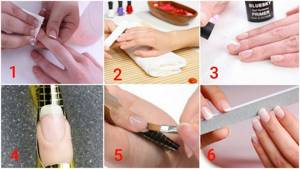
The procedure for extending short nails is not particularly difficult. To make this manicure easy even for beginners, you need to follow the following recommendations:
- Make sure there are no wounds or cracks on the skin near the nails. If necessary, treat inflamed areas prior to your scheduled procedure.
- It is best to treat the cuticle by sliding it with a wooden stick without using a trim manicure.
- Before fixing forms or tips, additionally sand the nail plates with a soft file or cutter. This will allow the attachment tool to lock in place better.
- For better disinfection of the skin and plates, after the primer has dried, hold your hands under the lamp.
- Make sure that your fingers and hands do not move when applying acrylic or gel. This helps avoid damage to the uncured coating.
Any manicure technique requires sufficient experience. A short simulation is an ideal option for mastering the extension procedure.
How to care for extended nails?
Becoming the owner of beautiful long nails in the modern world is not a problem. You need to find a professional master who will do the extensions efficiently and beautifully.
Then the task of the owner of beautiful claws is to preserve this beauty for a long time. Extension technology provides such a chance.
Applying artificial nails () has become a popular innovation for modern women. A woman always wants to look attractive and unique.
Long, well-groomed nails are stylish, aesthetically pleasing and fashionable. Women prefer to grow their own nails for a number of reasons.
Preparatory activities before the procedure
It is necessary to do a manicure before extensions.
Before applying nail extensions, the following conditions must be met:
- Do the latter 2-3 days before working on your nails;
- Seven days before the nail application session, you can undergo a course of strengthening procedures: baths, drink vitamins, perform a massage;
- If there are problems with the nail plates (dilated blood vessels, thin and sensitive skin around the cuticle), you need to visit a manicurist a week before extensions;
- Before working on nails, do not use paraffin and oil baths, because these substances are absorbed into the nails and prevent the adhesion of artificial nails;
- Make your nails moderate in length.
Immediately before the procedure in the hairdresser itself, you should pay attention to the following things:
- make sure that the master prepares your nails well before applying artificial nails;
- how the nail plate is filed. It is enough to simply cut it down, removing the shine; it should be thicker than a sheet of paper;
- No air should get between your nails and artificial ones. This allows bacteria and infection to enter;
- all instruments must be sterile, grinding files must be new;
- Please note that quality services from a professional are expensive.
The entire procedure takes from 1.5 to 3 hours.
What material are nails made of and their length?
Nails can be acrylic or gel.
Gel and acrylic are used for extensions. When using acrylic, odor may be present and disturbing. Acrylic nails should be protected from acetone.
The advantage of this material is a quick and safe method of removing nails by simply soaking in acetone or a liquid containing acetone.
Gel also has its drawbacks. When attaching gel material, nails can only be removed by filing. Mandatory placement of nails in a lamp for polymerization requires time, which makes the procedure longer.
For everyday life, the optimal nail length is chosen individually. For the first time, leave a short length.
A longer size of the nail plate is used in subsequent extensions; women quickly get used to it.
Extensions on short nails
Fate treats everyone differently. She gifts some with large expressive eyes, thick hair, even snow-white teeth, beautiful and durable nails of ideal shape; others get a little of her bounty. Fortunately, modern advances in the beauty industry make it possible to solve almost all problems associated with appearance correction. So, your client has practically no free edge of the nail. You can perform extensions both on tips and on forms.Extension on tips
STEP 1. After preparing natural nails, which consists of pushing back the cuticle, removing the fatty film, dehydrating and disinfecting the nails (photo 1) , tips are glued. In the case of traditional modeling, the contact area of the tip is almost completely removed from the nail so that it is not visible through transparent acrylic. When covering with an opaque material, the contact area of the tip should be completely removed only on the sides to avoid further lifting of the material (2) . It is then cut to the required length (3) and filed to the desired shape.
STEP 2. Lay out the first zone and the smile line with white acrylic. Its corners should be located at the corners of the natural nail, and the middle part should be below the natural smile line. This position of the smile line has two advantages: it increases the length of the nail plate and provides a beautiful oval of the nail bed (4a, 4b) .
STEP 3. Lay out the second and third zones with opaque acrylic as in normal modeling (5a, 5b) .
STEP 4. File and polish your nails (6) .
Extension on forms
STEP 1 . After preparing the nails, put on the form and begin working on the first zone (7) . In this case, it is necessary to correctly determine the position of the highest point on the modeled nail. It will be located in the middle of a line running along the axis of the nail from the cuticle to the free edge. To create a center of gravity, it is necessary to make the height of the first zone sufficient.
STEP 2. Lay out the free edge with white acrylic so that its tips meet the natural nail only in the very corners of the sides (8) . The middle part of the first zone appears to be hanging in the air and does not connect with the natural nail. The size of the resulting gap should not be too large so that the acrylic does not protrude beyond the fingertip. (If the “hanging” part is much larger than the one that lies on the nail bed and fingertip, then the strength of such a nail will be insufficient (Fig. 1) ) Pay attention to the height of the first zone in its central part (9)
STEP 3. Line the second zone with opaque acrylic to camouflage the true length of the natural nail and its smile line (10) .
STEP 4. The third zone can also be covered with this acrylic. But you can do it differently by using regular pink or transparent powder near the cuticle. In this case, the transition from the natural nail to the coating will not be so noticeable, which will significantly simplify the correction in the future (11a, 116) .
STEP 5. File your nails as usual, finish the procedure by polishing your nails with oil. The oil increases the elasticity of natural nails, therefore extending the life of artificial nails. In addition, thanks to the oil film on the nail, the rate of the polymerization reaction increases, which prevents the participation of oxygen in the reaction. In addition, the oil gives the cuticles a neat appearance.
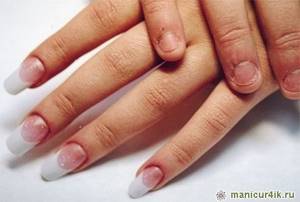
The difference in the appearance of the hand before and after modeling is obvious (12) . We wish all masters success in mastering the new technology!
Zornitsa ATANASOVA-KRYNSKAYA, nail modeling instructor
Did you like the article? Share with your friends!
Similar articles:
- The times when expectant mothers walked around with half their heads grown out and wearing the same shapeless overalls are long gone. Nowadays there are many stores where very beautiful fashionable clothes and special cosmetics are presented for pregnant women…
">Nail extensions during pregnancy
- Lifting, or detachment of artificial material from the natural nail plate, is one of the most common problems in modeling and one of the main reasons for client dissatisfaction. Lifting can have a different origin. There is no…
“>Lifting and the reasons for its appearance
- Recently, artificial nail extensions have become a popular procedure in beauty salons. With the help of extended nails, you can visually improve the condition of your nails, extend the durability of your manicure, increase the quality of your nail design, etc. Everyone wants...
“>Is nail extension harmful?
- Many clients and professionals believe: the thicker the artificial nail is modeled, the stronger it will be and the better it will wear. This misconception leads to breakage and an unaesthetic appearance of the hands of the owner of such nails. The free edge is, of course...
">Apex in artificial nails
- As soon as something starts to become popular, there are immediately people who oppose such a product or service. About what misconceptions exist today about the dangers of nail extensions and also about what mistakes...
">Nail extensions - misconceptions of clients and mistakes of professionals
How to care for extended nails, care after the procedure
After extensions, nails shrink, especially in the first day. Thus, the polymerization process is completed. Women feel a slight tightening, this lasts no more than two days, and in the future she does not experience any discomfort.
Proper care of extended nails
Rules that will prolong the wear of extended nails.
To ensure that nails made from artificial material look like real ones, bring aesthetic pleasure to the owner and others, and last as long as possible, follow simple rules:
- After attaching the nails for the first time (within 24 hours), they should not be soaked in water or undergo thermal procedures. Temperature changes are harmful to them;
- To change the varnish, remove it with a liquid without acetone;
- Avoid touching household chemicals that contain acetone;
- You should straighten the tips of your nails not with a metal file, but with a special file for artificial nails;
- Use only high-quality acrylic and gel varnishes, carefully studying the composition and expiration date;
- cover with one or two layers to allow them to breathe. It is good to use a base under the varnish;
- When performing all housework, protect your hands with gloves; do not expose your nails to mechanical stress or stress;
- Work with knives and graters carefully, without disturbing the integrity of the nail;
- Do not expose your nails to open flames (lighters, matches).
At home, the nail plates of the hands should be kept in good condition:
- use oils containing vitamins, gels, creams to nourish and moisturize the cuticle. Products reduce the formation of burrs;
- when the cuticle grows rapidly, special creams are used that reduce its growth;
- When doing your own nail manicure, use a remover to soften and remove the cuticle.
It is important to correct overgrown areas in a timely manner and apply new nails to them. On average, you need to contact specialists 1-2 times a month, taking into account individuality.
With new nails you can do water and steam treatments (saunas, steam baths, swimming pools), but be careful, they become fragile and brittle. After these visits, the nails need time to dry and cool down.
What to do if your nail extensions peel off
- If you notice that your nails began to peel off literally 2-3 days after the procedure, then first of all you need to inform your manicurist about this. It is quite possible that the only correct solution to this problem will be re-extension using a different technology and other materials, or a simple correction. As the reviews of those who have encountered this say, this is the only solution until the nail falls off completely.
- But there is still something you can do on your own, namely, properly care for such nails. Perhaps this is where the problem of peeling lies, you should know and remember a few basic rules for caring for extended nails.
- Remember that immediately before the procedure itself, you should not do a manicure at least 4 days in advance. This is very important, because after a manicure micro-cuts may remain, and this in turn can cause inflammation and detachment. Also, you should not nourish the cuticles and nail plate with oils; this excess moisture can further lead to peeling of the nails.
If your nail extensions are peeling, you may simply be not caring for them correctly. You should know that immediately after the nail extension procedure, you cannot do a manicure for 2 days, and you should also not visit a bathhouse or sauna for two days, since during these two days the natural nail adapts to the extended one. That is why minimize work with water these days or do everything with rubber gloves.
- You should not file your nails yourself, as it is easy to damage the so-called stress zone and cuticle, and this in turn will lead to nails peeling off or breaking.
- Do not bite your nails with nail clippers or scissors; to shorten your nails, you should only use a special nail file.
- Using a professional primer will help keep your extended nails looking great longer.
Manicurist Anastasia Luksha shows what can happen if correction is not done on time and what peeling leads to:
Contraindications and how to remove nails
There are different removal methods for gel and acrylic.
All growing parts of the human body need oxygen; a lack of it leads to cell death. The same thing happens with nails. When using artificial materials, the supply of oxygen is constantly reduced or stopped.
Artificial nails are removed at least once every two years, and they are allowed to rest and recover for 2-3 months, or even six months. During rest from false nails, restorative treatment sessions are carried out using creams, oils, and masks.
It is useful to use the following recipe to improve your nails: heat a tablespoon of olive or regular sunflower oil, apply it to the nail plate, lightly massaging it. Then polish with a piece of suede.
This will protect your nails from peeling. If you do it at night, you can also apply a nourishing or moisturizing hand cream and wear cotton gloves. When stratification occurs, salt baths are useful.
Take 200 ml of warm water, add 0.5 tablespoon of salt, and immerse your hands for 20 minutes. Do 15 days daily. For prevention purposes, you can do it once a week.
Iodine baths help strengthen the nail plate. Add 5-6 drops of iodine to a glass of warm water and lower your hands for 15 minutes. Do it every day for two weeks, then take a break for a week and do the course again.
The main function of the nail plate is protection. If you constantly extend your nails, they become thin and brittle, and painful sensations may appear.
If there is a defect or fungus in the nails, it is not recommended to extend them, as this will aggravate the situation of diseased nails. Another aspect is individual intolerance to coating materials.
An allergy to acrylic can appear after six months, usually in the form of hives. It occurs in the form of itching in the area of the nail bed. If you have a possible allergy, you can try one nail and see the reaction.
Experts do not advise experimenting with nails during pregnancy, taking antibiotics or undergoing chemotherapy. Nails should only be removed by a specialist, after which they are covered with a thin layer of varnish so that they can rest and prevent infection.
To keep your own nails healthy and beautiful, you need to follow simple rules and follow the recommendations, then extended nails will not cause problems and will become your calling card, make your hands well-groomed, and make you the most attractive and charming.
From this video you will learn how to care for extended nails.
To decorate your hands with long and strong nails, you can carry out the extension process. This is a painless procedure, thanks to which the desired shape and color of the manicure is formed. In order for such a coating to last long, it will require special care.
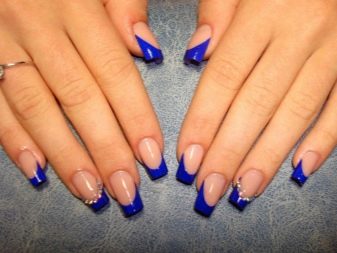
Reasons why extended nails come off
- The reason that the nails come off may be the mistakes of the master himself, for example, he could not properly prepare the nail itself before modeling, or a very thick or too thin layer of the material itself in the cuticle area could be the reason for this. Perhaps the so-called stress zone was modeled incorrectly; one of the most common causes of this problem is that the material itself gets on the cuticle when modeling the nail.
- Detachment is also possible on the nail, namely at its tip, due to the fact that the material did not get directly onto the sides of the nail. This is very important when applying the gel; it must cover all sides thoroughly. The reason that the extended nails come off may also lie in the fact that the detachment occurs directly from the reverse side, that is, the reason is in the natural nail itself.
- But you yourself can also cause this to happen to your nails, for example, due to the fact that you are taking antibiotics, which can cause the rejection of foreign materials from your nails. If you are pregnant or have diabetes, this may be the reason, since a lot of antibodies are produced.
Drawing a beautiful smile line is quite easy and the correct technique will prevent detachment.
Master Evgeniya Vidinei in the video shows how to prevent the material from peeling off natural nails:
Preparation
After deciding to decorate your hands with an artificial manicure, you will need to visit the master in order to learn about the rules of care before starting work. Three days before the extension, the plates are treated with a classic or European manicure. At this time, the nails are given the necessary shape, and excess cuticle is removed. This type of work promotes neatness and well-groomed hands.
Those women who decide to visit a manicurist should not use hand creams and oils before getting extensions done. Otherwise, there will be no strong adhesion between the artificial and natural plates. The same applies to oil manicure, as well as paraffin therapy.
Features of care
You need to start caring for your extended nails immediately after the procedure. The first twenty-four hours are the most important for the subsequent condition of the marigolds. The basic rules of care are as follows.
- Do not use nail products based on acetone. Such substances are detrimental to manicure extensions, as they corrode its structure. After work has been done on the nails, their color scheme does not change for a long time, so the woman will wear the same manicure until correction. That's why when choosing a nail design you should give preference to versatility.
- Doing housework should be done using gloves. Such “hand clothing” helps protect the nail plates from mechanical and chemical damage. In addition, gloves are an excellent way to prevent premature aging of the skin of your hands.
- Correction must be done on time. Due to the constant growth of the nail plate, the acrylic or gel base will move away from the nail base. To maintain the proper appearance of your manicure and avoid constant clinging to objects and things, you should come to the master at the appointed time, without missing corrections.
- It is necessary to take care of gel nails at home. After regularly checking the edges of your nails, they should be carefully filed. Using a nail file will prevent snagging. Otherwise, the woman may experience pain from the injury, and the resulting damage will take a long time to recover.
- Care must be taken at all times to prevent mechanical damage. It is forbidden to knock your nails or open anything with them. The strength of the nail plate will not protect it from brittleness. A broken nail entails damage to the natural one.
- You should be careful about temperature changes. Do not touch hot things with your nails, otherwise the manicure will turn yellow, crack and become unusable.
It is necessary to constantly care for the skin around the nails; it is recommended to nourish and moisturize it, so that hangnails will not form.
Simple design for short nails - water manicure.
It is also worth noting that ordinary designs on short nails do not look very good, since there is not much space for drawing, but interesting and vintage designs that are obtained as a result of water manicure look simply excellent, visually lengthening the nail. That is why many girls use water manicure. In addition, this type of drawing allows you to use all your imagination to come up with a wide variety of interesting drawings. You can choose a minimum of two colors, or all the colors of the rainbow, mixing them together.
Drop the varnish into the water and wait until it spreads across the surface of the water. After that, add a few more flowers. Using a toothpick, draw out any pattern of your choice. Then quickly dip your finger under the water. After you take it out, you will notice that there is a design left on the nail. After this, you can clean your nails of excess varnish and you can consider that your water manicure at home is ready.
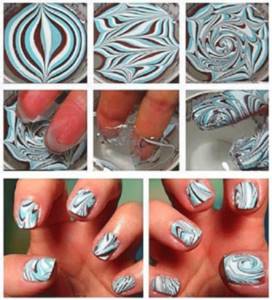
- Related Posts
- REASONS FOR MATERIAL DETACHMENT WHEN NAIL EXTENSION
- French manicure “Love confession”
- French manicure “Space”
- INTERIOR NAIL DESIGN “STARRY NIGHT”
- Master class on nail extensions “Awakening of Spring”
- SHOULD I USE ANTI-FUNGAL PREPARATIONS WHEN NAIL EXTENSION?
Supportive procedures
After performing a manicure and the process of nail extensions, such an unpleasant phenomenon as cuticle regrowth occurs. This situation results in sloppy and untidy looking hands. At an advanced stage, nails become sloppy. There is nothing complicated in solving this problem. With regular use of oils and creams that are aimed at caring for the cuticle, you can avoid an unpleasant situation.
If your nail is broken, you should not use super glue to restore it. The best way out of this situation would be to wrap the affected finger and make an appointment with a specialist. In order to fill the void on the plate when a natural nail grows, you will also need to visit a specialist in time and make a correction. This procedure should be carried out every three to four weeks.
Don’t be alarmed if, after stress, a course of antibiotics, hormones, or pregnancy, your extended nails suddenly begin to break. This is a normal reaction of the body to a foreign body. When the condition returns to normal, you can safely get a new beautiful manicure.
What can you do with extended nails and what not? How should you take care of your nails after removing extensions? I often hear these questions from my clients, so I decided to post my own tips. I developed each of them myself, from my own experience, so you can rest assured of their usefulness and expediency. Moreover, the further, the more women, in fact, are planning the procedure for nail extensions. This information will be one hundred percent interesting for you. Of course, there is a lot of information on the Internet on this topic, so it’s worth boiling it down to simple tips.
So, what are the basic requirements and features on how to properly behave with such nails? Begin.
Nail extensions
Women need too much time to take care of themselves: skin, body, hair and nails. To always look flawless and well-groomed, modern girls who keep up with fashion use some beauty procedures so as not to spend a lot of time every day creating an image. Services such as nail extensions, manicures, pedicures, fashionable haircuts and styling, facial cleansing, beauty injections, etc. will help save time for relaxation and for family. Let's look at the pros and cons of gel coating in this publication.
Care for gel nails
Rule number 1. Make corrections on time
Extended nails and care for them are two closely related phrases. And correction is always included with care. This is a procedure where your nail plate grows and the extended nail increases in length. The larger it is, the greater the likelihood of breaking it, or getting a perfect crack. At the same time, partial detachment is possible. After all, the center of gravity changes and the extended part begins to stay only on the tip of the nail. Now, where there was less gel, or the fixation is weaker, stress or external pressure can lead to breakage or loss. Why is this dangerous? Because along with the extended part, your nail part may also peel off. Therefore, ask how long you can wear your extended nails and when you should pay attention to correction.
Rule number 2. Do not use super glue if your nail breaks unless absolutely necessary.
Since this is very popular and many women say that this way you can get out of an ambiguous situation, I will tell you what the dangers are. If you plan to visit your master in the near future, then do not use glue. Because even specialized nail adhesives are designed to help you temporarily, not permanently. The best option is to wrap it with adhesive tape and make an appointment. The glue can cause as much damage as the injury you are trying to fix. This is only a temporary step and only for a day or two.
Rule number 3. Choose and use cuticle oil on a regular basis
After all, you not only take care of the skin of your cuticle, but also the skin of your hands in general. Nails also receive their share of vitamins and elements and become stronger. This makes them much easier to bear external pressure during dressing, cleaning or affection. It 100% improves the appearance of both hands and manicure on your neat hands. Nail extensions become simple and affordable on healthy, good hands.
Rule number 4. Water SPA procedures for nails are not done at the same time as the main manicure with extensions
You yourself know very well that fingers, especially the skin on the fingers, after a long stay in water, gain moisture, and then they will release it outward. This way, the peeling of the artificial material, which is the extension gel, is stimulated. Therefore, the master will only perform dry cleaning before extensions and use only cuticle softeners.
Rule number 5. Do not subject your hands to heavy physical activity.
This advice seems ridiculous, but I must point it out again. Extended nails are not your fingers that can easily carry both light and heavy objects, open doors and press your nails on a keyboard or touch screen. Extended nails are a special art of beauty and require careful handling.
Rule number 6. Sudden temperature changes have a negative effect on artificial nails
This does not mean that you shouldn’t do extensions in winter, but that you shouldn’t immediately wash your hands with hot water after coming in from the frosty air. Or after a steamy sauna, dive into the cold water of the pool. It's possible that you shouldn't combine extensions and extreme changes on the same day.
Rule number 7. Use gloves when cleaning
Common household chemicals in the kitchen and bathroom contain compounds that are difficult to pronounce. And some of them harm healthy nails, not to mention artificial ones with beautiful, neat designs on them.
What to choose for short nails - nail extensions or gel polish?
As a rule, women complain that they cannot grow the nails they have always dreamed of. Indeed, it is not uncommon that due to a lack of vitamins, overgrown nails very often break and peel, losing their good appearance. This is actually why many women resort to nail extensions. Nail extensions during the period of weakening of the nail platinum is not the best choice. Long extended nails can become an unbearable burden on the nail plate, which is weakened and flakes. Applying gel polish is an excellent choice for women who complain of brittle and peeling nails. Gel polish in classic shades looks amazing on short nails, adds elegance to your look and makes your hands look neat.
